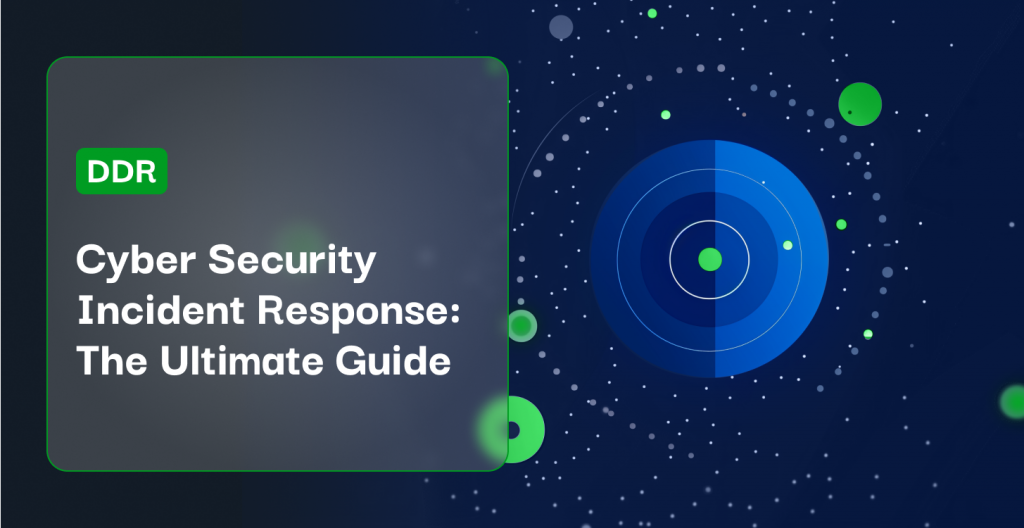Efficient response plans for cyber security and data breach incidents are essential for maintaining the overall health of an enterprise. As more companies migrate to the cloud, new breach vectors occur. Without proper response plans in place, companies risk additional damage to client trust, financial ramifications, and legal scrutiny. Cyber security incident response plans and data breach incident response plans are therefore crucial. This guide itemizes the key steps involved in developing response plans that are actionable and effective.
Jump to a section…
Cyber security Incident Response Plan Best Practices
Promote Efficient Internal Communication
Inform External Sources
Ensure Regulatory Compliance
Developing a Cyber security Incident Response Plan
Preparation
Detection & Analysis
Containment, Eradication, and Recovery
Post-Incident Activity
Data Breach Incident Response Best Practices
Limit the Size of Your Response Team
Let Your Team Lead the Way
Developing a Data Breach Incident Response Plan
Alert Your Incident Response Team
Perform Audits and Develop Key Findings
Be Prepared Before an Incident Occurs
Looking to improve your data security posture management, cloud security, and get insights into your enterprise’s network? Symmetry Systems can help. Request a demo today to see what we can do for you.
Cyber Security Incident Response Plan Best Practices
Before creating a cyber security incident response plan, research best practices that will guide the process. These best practices can help with the nitty-gritty of forming a response that can mitigate any damage that may result from an incident.
Promote Efficient Internal Communication
Cyber security incident response plans rely on effective communication to work well. Your incident handlers should be equipped with all the resources they need to communicate efficiently, even when digital communication isn’t an option. Create a clear hierarchy for escalating and documenting issues, lessening the confusion during what is bound to be a chaotic time.
Inform External Sources
Don’t try to hide a cyber security incident from the public. These events can have significant impact on share value and public perception, so you should keep the general population in the know. Inform the media and customers directly that an incident has occurred, while also listing the breach in a government database.
Ensure Regulatory Compliance
You may be legally liable for the mishandling of consumer data depending on the scale and severity of the cyber security incident that has occurred. GDPR, for example, mandates that you report the incident within 72 hours of becoming aware of it. During the initial stages of designing your cyber security incident response, consult your legal team about any considerations that you may be responsible for.
For more information, read our blog post 9 Cyber Security Incident Response Best Practices.
Developing a Cyber Security Incident Response Plan
The National Institute of Standards and Technology has developed a guide for the foundational principles of developing a cyber security incident response plan called the Computer Security Incident Handling Guide. There is no one-size-fits-all solution, but the core principles outlined by NIST define the framework for handling an efficient response in four steps.
Preparation
Analyze case studies of high-profile cases, identifying how they took place and were responded to. Use this to inform your own process for discovering patterns, online communication, assembling a response team, and creating contingencies for a range of incidents.
Detection & Analysis
There are two signs of cyber security breaches as defined by NIST: precursors and indicators. Precursors are signs of an incident that hasn’t happened yet, while indicators show one has occurred. Precursors are difficult to detect but include announcements from perpetrators and weblogs revealing vulnerability scanner activity. Indicators may comprise antivirus scanner alerts, a network intrusion detection alert, or a host record showing auditing configuration changes.
Cyber security incident analysis is at the mercy of false positives. Indicators need to be analyzed to determine legitimacy, and may not equal a full-fledged breach. Automated systems can detect a data security breach, though your cyber security incident response plan should include a team of specialists capable of performing analysis, finding unusual behaviors, dissecting normal behaviors, creating a log retention policy to preserve evidence of the attack, and performing event correlation to capture data about the breach.
Containment, Eradication, and Recovery
Cyber security incident response plans should account for the documentation and preservation of evidence, resources that will be necessary for the containment process, and determine how long a workaround solution will remain in place during incidents. Containment can result in additional damage, depending on its type and extent, so be prepared for possible residual issues.
Eradication and recovery entail identifying any potential residual issues caused by the cyber security incident, closing vulnerabilities, disabling breached accounts, and solving any other issues within the host that need to be addressed. In some instances, eradication will be addressed during the recovery process, which should be performed in a phased approach so that remediation steps are prioritized.
Post-Incident Activity
Cyber security incident response plans should leave room for enterprises to reflect. What caused the initial breach? What procedures need to be put in place now? Finding the root of the problem and moving forward is critical. For many, the answer is following a Zero Trust philosophy .
For more information, check out our blog post How To Develop A Cyber Security Incident Response Plan.
Data Breach Incident Response Best Practices
Data breaches are a specific category of the broader cyber security world, one significant enough to demand its own best practices. Not only that, but they’re a common threat faced by information-driven companies. In fact, Verizon’s 2021 Data Breach Investigations report confirmed that 5,258 data breaches occurred in 2020 alone, with a total of 79,635 cyber security incidents surveyed. The sheer volume of these attacks is evidence that no company is safe from threats. These best practices will take the core of the standard cyber security incident response a few steps further.
Limit the Size of Your Response Team
Once you’ve identified the threat to your enterprise as a data breach, you can better coordinate the size and composition of your response team. This team should consist of members from the affected departments as well as your security team. Here are a few common parts of the business that should be involved.
- IT Department: A critical player in any response team. These team members should be chosen based on their capability to communicate and collaborate with other departments effectively.
- Product Team: Including a representative from the product team will ensure that your organization can return to work as efficiently as possible.
- Human Resources: Data breaches aren’t always perpetrated by external sources. In the event that an internal party is responsible for the data breach, you’ll need to bring human resources representatives.
- Marketing & Communications: Someone will need to deliver your message as part of a data breach incident response. Bringing marketing into the situation early can help with sharing the news.
- Legal & Finance: These teams should determine what the potential legal ramifications of a breach are, how to prepare for those ramifications, and what the total cost could end up being.
Let Your Team Lead the Way
Once you’ve created a team and identified a breach, begin working to defend your cloud assets. Your top priority is to seal off any vulnerabilities to prevent future incidents. You’ve created a team of professionals, so follow their direction. If you’re looking for more information on the process, cyber security expert and Symmetry Systems CEO Mohit Tiwari addressed how purple team tactics can be used to help security teams surface hidden vulnerabilities and achieve a Zero Trust posture in cloud environments during a recent webinar.
For more information, read our blog post 6 Cyber Security Incident Response Best Practices to Protect Your Enterprise.
Developing a Data Breach Incident Response Plan
Once you’ve built an understanding of the best practices, it’s time to formulate an in-depth plan to respond to data breach incidents. This plan will adopt many of the same core concepts as the cyber security incident response plan, in that you should be transparent in your external communication and emphasize mitigation. An efficient response will also include the following steps.
Alert Your Incident Response Team
Your data breach incident response team should be made aware of the data breach as soon as it has been detected. Time is of the essence. Alerting your IRT before any other step gives them the most time possible to coordinate a response. Once that’s done, contact your insurance provider. You’ll want to have negotiated coverage for data breach incidents well in advance, covering as many potential types of breaches as possible. Insurance companies will often have investigative teams of their own and will be a great asset as you navigate through the issue.
Perform Audits and Develop Key Findings
Once the IRT and your insurance company are privy to the issue, it’s time to get to the bottom of what happened. Thoroughness is a crucial part of this process, so you and your IRT should go to great lengths to understand precisely what the causes of the data breach are, which parts of the business have been impacted, and what client data was leaked. As this is happening, the IRT should work to mitigate the threat on every level, patching vulnerabilities and containing the issue. This means eliminating compromised accounts, malware removal, and destroying harmful artifacts. You should then determine the effectiveness of your response, coordinating with your team to determine what was effective and what wasn’t. Once again, remain transparent throughout the entirety of the event, informing the media and clients of the breach’s scale and scope.
For more information, check out our blog post The Definitive Data Breach Incident Response Plan Checklist.
Be Prepared Before an Incident Occurs
Preparation is half the battle, regardless of the type of incident you’ve experienced. A successful strategy for both cyber security and data breach incident response plans begins with finding a data security partner well before even precursory hostility has taken place. Symmetry Systems’ DataGuard platform can help you make these preparations, giving you a direct line of sight into your enterprise’s data. Built to halt malicious parties in their tracks, DataGuard offers recommended next steps for cyber security and compliance risks, as well as an ongoing detection and response service. Request a demo today to learn more.






